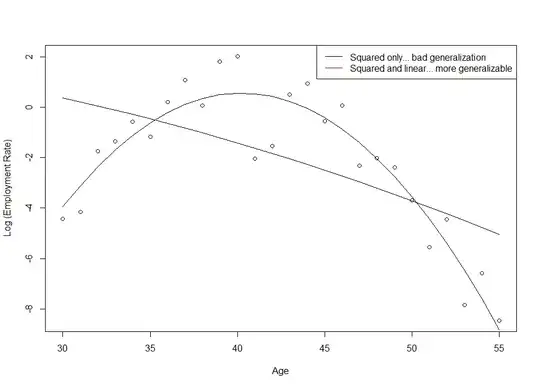I am inclined to agree with @StasK's comment. However, something like what you want is feasible, though a little tricky to interpret. What I propose below tells you how the marginal effect of $x$ varies with $x$.
You know that the conditional mean of the dependent variable in a probit model is
$$\mathbb{Pr}[y=1 \vert x,z]=\Phi(\alpha + \beta \cdot x + \gamma \cdot x^2+z'\pi).$$
The variable $x$ is what we care about. The vector $z$ contains some other covariates. $\Phi(.)$ is the standard normal cdf, and $\varphi(.)$ is is the standard normal pdf, which will be used below.
The marginal effect of $x$ is
$$\frac{\partial \mathbb{Pr}[y=1 \vert x,z]}{\partial x}=\varphi(\alpha + \beta \cdot x + \gamma \cdot x^2+z'\pi)\cdot(\beta + 2\cdot\gamma \cdot x).$$
The change in the marginal effect is the second derivative
$$
\frac{\partial^2 \mathbb{Pr}[y=1 \vert x,z]}{\partial x^2} =
\varphi(\alpha + \beta \cdot x + \gamma \cdot x^2+z'\pi)\cdot(2\cdot\gamma) +(\beta + 2\cdot\gamma \cdot x)\cdot\varphi'(\alpha + \beta \cdot x + \gamma \cdot x^2+z'\pi).
$$
Since $\varphi′(x)=−x \cdot \varphi(x)$, this "simplifies" to
$$
\frac{\partial^2 \mathbb{Pr}[y=1 \vert x,z]}{\partial x^2} =
\varphi(\alpha + \beta \cdot x + \gamma \cdot x^2+z'\pi)\cdot \left[ 2\cdot\gamma -(\beta + 2\cdot\gamma \cdot x)^2\cdot(\alpha + \beta \cdot x + \gamma \cdot x^2+z'\pi)\right].
$$
Note that this is a function of $x$ and $z$s, so we can evaluate this quantity at various possible values. Also note that while the first term is surely positive since it is a normal density, it's hard to sign the second term even if you know the sign and magnitude of the coefficients.
Assuming that I didn't screw up the derivative, here's how I might actually do this in Stata:
#delimit;
sysuse auto, clear;
probit foreign c.mpg##c.mpg c.weight, coefl;
/* At own values of covarites */
margins, expression(normalden(predict(xb))*(2*_b[c.mpg#c.mpg] - predict(xb)*(_b[c.mpg]+2*_b[c.mpg#c.mpg]*mpg)^2));
/* At chosen values of covarites */
margins, expression(normalden(predict(xb))*(2*_b[c.mpg#c.mpg] - predict(xb)*(_b[c.mpg]+2*_b[c.mpg#c.mpg]*mpg)^2)) at(mpg=20 weight=3000);
/* At avermpg value of covariates */
margins, expression(normalden(predict(xb))*(2*_b[c.mpg#c.mpg] - predict(xb)*(_b[c.mpg]+2*_b[c.mpg#c.mpg]*mpg)^2)) atmeans;
If I was doing this myself and feeling lazy, I might use adjacent reverse contrasts. For instance, here's the second derivative evaluated at 4 values of $x$:
margins, expression(normalden(predict(xb))*(2*_b[c.mpg#c.mpg] - predict(xb)*(_b[c.mpg]+2*_b[c.mpg#c.mpg]*mpg)^2)) at(mpg = (10 20 30 40));
Here's a comparison of the derivatives. This compares the marginal effects of mpg at mpg of x+1 to the marginal effect at mpg of x:
margins, dydx(mpg) at(mpg = (10 11 20 21 30 31 40 41)) contrast(atcontrast(ar(2(2)8)._at) wald);
Note how close the two commands' outputs are, but the second is so much easier.
I don't know what r is your code, so I can't verify if what you have is correct.
